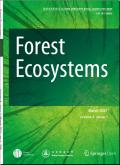Demystifying field application of Critical Height Sampling in estimating stand volume
IF 4.4
1区 农林科学
Q1 FORESTRY
引用次数: 0
Abstract
Critical Height Sampling (CHS) estimates stand volume free from any model and tree form assumptions. Despite its introduction more than four decades ago, CHS has not been widely applied in the field due to perceived challenges in measurement. The objectives of this study were to compare estimated stand volume between CHS and sampling methods that used volume or taper models, the equivalence of the sampling methods, and their relative efficiency. We established 65 field plots in planted forests of two coniferous tree species. We estimated stand volume for a range of Basal Area Factors (BAFs). Results showed that CHS produced the most similar mean stand volume across BAFs and tree species with maximum differences between BAFs of 5–18 m3·ha−1. Horizontal Point Sampling (HPS) using volume models produced very large variability in mean stand volume across BAFs with the differences up to 126 m3·ha−1. However, CHS was less precise and less efficient than HPS. Furthermore, none of the sampling methods were statistically interchangeable with CHS at an allowable tolerance of ≤55 m3·ha−1. About 72% of critical height measurements were below crown base indicating that critical height was more accessible to measurement than expected. Our study suggests that the consistency in the mean estimates of CHS is a major advantage when planning a forest inventory. When checking against CHS, results hint that HPS estimates might contain potential model bias. These strengths of CHS could outweigh its lower precision. Our study also implies serious implications in financial terms when choosing a sampling method. Lastly, CHS could potentially benefit forest management as an alternate option of estimating stand volume when volume or taper models are lacking or are not reliable.
揭秘临界高度抽样在林分体积估算中的野外应用
临界高度抽样(CHS)估算的林分体积不需要任何模型和树形假设。尽管早在40多年前就已推出,但由于测量方面的挑战,CHS尚未在该领域得到广泛应用。本研究的目的是比较CHS与使用体积模型或锥度模型的采样方法之间的估算林分体积,采样方法的等效性及其相对效率。我们在两种针叶树人工林中建立了65个样地。我们估算了一系列基础面积因子(baf)的林分体积。结果表明:灌木林产生的平均林分体积在不同的baf和树种之间最为相似,baf之间的最大差异为5 ~ 18 m3·ha−1;使用体积模型的水平点采样(HPS)在各baf的平均林分体积上产生了非常大的变异,差异可达126 m3·ha−1。然而,CHS的准确性和效率低于HPS。此外,在允许容差≤55 m3·ha−1时,没有一种抽样方法与CHS具有统计学上的互换性。约72%的临界高度测量值在冠底以下,表明临界高度比预期更容易测量。我们的研究表明,在规划森林清查时,平均CHS估计值的一致性是一个主要优势。当对CHS进行检查时,结果提示HPS估计可能包含潜在的模型偏差。CHS的这些优势可能会抵消其较低的精度。我们的研究也暗示了在选择抽样方法时财务方面的严重影响。最后,当缺乏或不可靠的林分体积或锥度模型时,CHS作为估算林分体积的替代选择可能对森林管理有益。
本文章由计算机程序翻译,如有差异,请以英文原文为准。
求助全文
约1分钟内获得全文
求助全文
来源期刊

Forest Ecosystems
Environmental Science-Nature and Landscape Conservation
CiteScore
7.10
自引率
4.90%
发文量
1115
审稿时长
22 days
期刊介绍:
Forest Ecosystems is an open access, peer-reviewed journal publishing scientific communications from any discipline that can provide interesting contributions about the structure and dynamics of "natural" and "domesticated" forest ecosystems, and their services to people. The journal welcomes innovative science as well as application oriented work that will enhance understanding of woody plant communities. Very specific studies are welcome if they are part of a thematic series that provides some holistic perspective that is of general interest.
 求助内容:
求助内容: 应助结果提醒方式:
应助结果提醒方式:


